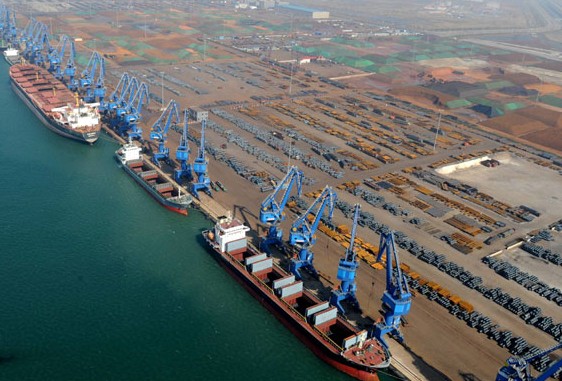

Caofeidian Harbor mainly serves Shougang Group, now in Tangshan, Hebei province. The harbor is connected to four main freight railway lines that link Northeast China, North China and western China. for CHINA DAILY
If size matters, Hebei district will win, but minuses loom very large
The Caofeidian industrial park of Tangshan city in Hebei province applied to the State Council in late February to set up a free trade zone, the local administration confirmed to the Information Daily newspaper on Tuesday.
If the plan is approved, the Caofeidian FTZ will become a new platform for the coastal province of Hebei to further open up to the world, local officials said.
According to Liu Zhuangsheng, vice-director of the Caofeidian Administration Commission, the FTZ would work off the operational model of Zhoushan Islands' new district in Zhejiang serving the Yangtze River Delta, and become a distribution center of import-export commodities for the region around Bohai Bay.
"As the integrated development of Beijing, Tianjin and Hebei speeds up, the market will gradually recognize Caofeidian's geographical importance and economic potential," Liu said.
Caofeidian, located 220 kilometers east of Beijing, consists of a 16 square kilometer peninsula formed by a 4 sq km islet and a broad land passage reclaimed from the sea in 2000 for the use of Shougang Group, the huge iron- and steelworks that was moved from Beijing to cut pollution for the 2008 Olympics.
The peninsula, which is suitable for building deepwater ports, is connected to four main freight railway lines that link Northeast China, North China and western China.
The Shanghai FTZ's establishment last year stiffened the Caofeidian administration's resolve to apply for a zone. To prepare its application, the local government invited a research team from the Commerce Ministry to visit on Oct 9 last year, 10 days after the Shanghai FTZ was launched.
Li Guanghui, team leader, concluded that geographical advantage, harbors, mineral resources, industrial base and efficient administration are the five strengths of Caofeidian.
According to the plan, Caofeidian will become a distribution center for ore, oil, natural gas, coal, grain and timber in North China.
There are, of course, downsides. Currently, the only things of note in the Caofeidian district, besides its ports and administrative buildings, are the iron- and steelworks, part of an industry operating at serious overcapacity.
And the fact remains that there already are plenty of deepwater harbors in Bohai Bay, including Dalian, Qinhuangdao, Yingkou, Tianjin and Yantai.
The FTZ application plan submitted by Caofeidian does not explain how it will succeed in competing with the other large ports. The petrochemical, power, manufacturing industries and service sectors exist only on paper so far.
Cheap land is Caofeidian's chief selling point. As its application plan stresses, at 210 sq km, its area of industrial land is much larger than that of the other applicants from better-off Guangdong, Zhejiang, Fujian and Shandong provinces.
According to China Business News, by the end of last year, the overall investment in Caofeidian hit 280 billion yuan ($46 billion) for a total of 217 projects, one-third of which is undertaken by the government.
It is estimated that the Caofeidian administration's government owed to the bank nearly 40 billion yuan in loans last year. How much the other investors owe their creditors can only be guessed.
The sparsely populated Caofeidian downtown today poses a stark contrast with the government's ambitious plan to set up an FTZ - which also is the goal of at least 30 other cities.
Analysts warn that local governments should recognize that the central government set up Shanghai FTZ to encourage them to try out reforms in key areas, such as finance, rather than just meting out preferential land and tax policies to secure economic growth.
Shanghai still container port leader
2014-01-04New port on Chinese coast to start trial operation
2013-12-22Copyright ©1999-2018
Chinanews.com. All rights reserved.
Reproduction in whole or in part without permission is prohibited.